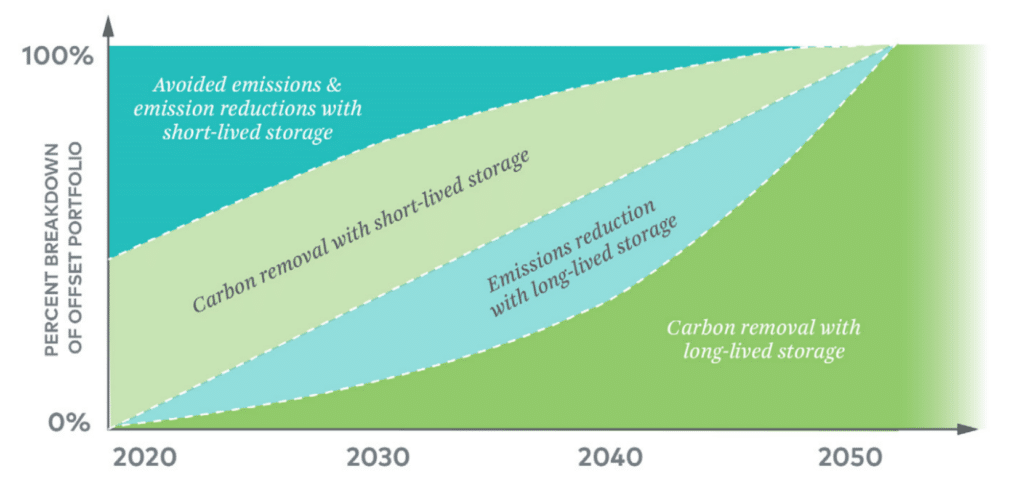As more companies look to address their carbon footprints, many realize that efforts to reduce their own emissions can be time-consuming and complex. Reaching long-term sustainability goals, like becoming a net zero organization, can take decades, and along the way, you might find that certain sources of carbon emissions are difficult or nearly impossible to truly abate.
For example, a technology manufacturing company might make great efforts to transport its products in electric vehicles charged via renewable energy, but the end user of the product might later charge those devices using electricity from fossil fuels, thus creating value chain emissions.
So, to reach net zero or other climate goals, many organizations are turning to carbon credits and, specifically, carbon removal credits. By funding carbon dioxide removal (CDR), where existing carbon is removed from the atmosphere, companies are able to further their commitment to support carbon reduction and removal activities outside of their value chain and do their part to help the world stay below 1.5°C of warming.
What are carbon removals?
Carbon removals generally represent the removal of one metric ton of carbon dioxide equivalent (MT CO2e) from the atmosphere. These removals come from carbon projects that remove existing greenhouse gases (GHGs), producing what is called a carbon credit, which can then be bought and sold. Companies often use carbon removals to account for their ongoing emissions while still looking for reductions. Additionally, some organizations use carbon removals to go beyond net zero and become carbon negative.
Examples of carbon removals
There are three main categories of carbon removals:
- Biological: Nature-based solutions remove existing carbon or other GHGs from the atmosphere. For example, reforestation projects can involve planting trees that sequester carbon as the trees grow.
- Hybrid: These types of carbon removal projects combine biological and engineered solutions. For example, biochar comes from burning biomass through pyrolysis, creating a charcoal-like substance that can improve soil’s ability to sequester carbon.
- Engineered: Carbon removal credits can also come from engineered solutions, like direct air capture and storage (DACS) systems. As the name suggests, DACS involves capturing carbon directly from the air and then sequestering that carbon, such as by injecting it underground.
Carbon removals vs. emission reductions carbon credits
Carbon removals are generally a form of carbon credits, but not all carbon credits are carbon removals. In other words, carbon credit is an overarching term for two subcategories: emission reductions and carbon removals.
Emission reductions involve avoiding emissions that would otherwise be created, such as preserving forest land that is prone to logging or capturing methane emissions at a landfill, as explained in The Oxford Principles for Net Zero Aligned Carbon Offsetting.
In contrast, carbon removals take existing emissions in the atmosphere and sequester them, such as by improving soil management or directly capturing existing carbon in the air and injecting it underground for permanent storage.
Why are carbon removals important?
Carbon removals are important because reaching long-term climate goals will likely require reducing the high level of emissions already in the atmosphere. Some types of emissions are nearly impossible to avoid. So, carbon removals will fill those gaps.
“All pathways that limit global warming to 1.5°C with limited or no overshoot project the use of carbon dioxide removal (CDR) on the order of 100–1000 GtCO2 over the 21st century,” says the Intergovernmental Panel on Climate Change (IPCC).
Additionally, organizations will likely need to include carbon removals in their sustainability strategies to meet their climate goals. For example, the Corporate Net-Zero Standard from the Science Based Targets initiative (SBTi) requires companies to cut more than 90% of their emissions and then “use permanent carbon removal and storage to counterbalance the final <10% of residual emissions that cannot be eliminated [by their net zero target year],” explains SBTi.
How should carbon removals be used?
Although carbon removals can sequester existing emissions, they do not give organizations license to emit freely.
Carbon removals should be used as a complement to long-term value chain emission reductions, rather than being the main tool in a climate strategy. Those who follow the SBTi guidelines, for example, will prioritize reducing their own emissions, with less than 10% of their emissions neutralized.
When looking to procure carbon credits, experts advise to begin incorporating removals early into your carbon strategy and increasingly prioritize removals over other credits as your target year for your emissions goals approaches.
However, because the world is significantly off-track to meet the emission reduction targets set out under the Paris Agreement, it is imperative that organizations take advantage of both avoidance and removal opportunities within and beyond their value chains today to manage the climate crisis.
For that reason, emission reduction credits are still a useful tool in the short term, especially considering the limited availability of carbon removal credits and the high cost of some projects today.
What are the key quality criteria for carbon removal credits?
Because carbon removal technologies and strategies have a wide range of maturity and accreditation, buyers should be mindful of how carbon removal credits meet key quality criteria. When assessing the quality of a carbon removal credit, you might consider criteria such as:
- Additionality: Would the carbon removal activity have occurred in the absence of the carbon market? Projects must provide evidence that the removals go beyond “business as usual.” For example, a reforestation project might be additional because it demonstrated that the tree planting activity would not have occurred without carbon finance.
- Durability/Permanence: How long will the carbon be sequestered? Some organizations set thresholds for the permanence of carbon removal solutionst, such as 100 or 1,000 years, while others use a tiered approach, grouping credits into short-, medium- and long-term storage. For now, there is no singular standard for what constitutes sufficient durability for carbon removals.
- Risk of reversal: Some carbon removal projects face significant risk of reversal, meaning they may re-release the carbon they sequestered. For example, a wildfire could cause a forestry project to lose carbon that it had stored.
To manage this risk, high-quality nature-based credits are supported by a shared buffer pool. Buffer pools require that a portion of issued credits from all participating projects are never sold, and are instead canceled or “retired” in case a purchased credit suffers a reversal.
- Accreditation: Third-party accreditation is an important indicator of quality and oversight in the voluntary carbon market. Although most emission reduction credits are registered under third-party standards, the newness of carbon removals means not all projects are accredited.
For carbon removal categories that do not have formal accreditation programs yet, companies might work with third-party consultants to assess the quality of these projects.
- Scalability: One reason to purchase carbon credits is to help scale environmental technologies and strategies to make them more mature or affordable. With carbon removals, it is important to consider the maximum total potential of a specific approach or technology to remove greenhouse gases from the atmosphere. Carbon finance should ultimately be directed to project categories that can effectively deliver carbon removal at a global scale. For example, Frontier is an “advance market commitment (AMC) that aims to accelerate the development of carbon removal technologies by guaranteeing future demand for them.” Founded by Stripe, Alphabet, Shopify, Meta, and McKinsey, the AMC focuses on carbon removals that can be affordable at scale, meaning they will cost less than $100 per ton.
- Co-benefits: Carbon removals can have benefits beyond removing greenhouse gas emissions. For instance, some projects improve biodiversity or create economic opportunities for local communities.
Soil carbon sequestration projects, for example, can also increase agricultural yields via improved soil health.
Organizations can also turn to third-party standards such as Carbon Direct and Microsoft’s Criteria for High-Quality Carbon Dioxide Removal to help assess the quality of different removal credits.
Where can organizations purchase carbon removal credits?
Organizations can work with climate consultants like 3Degrees to source carbon removals that align with your long-term sustainability strategy. 3Degrees is both a carbon credit project developer and retailer that can help you find climate finance opportunities to meet long-term climate goals.
To reach net zero, for instance, you first need to understand your carbon footprint, which an advisor can help calculate. From there, we can work together to identify ways to reduce emissions within your value chain, and then source carbon credits to address any remaining emissions.
Want to see how you can incorporate carbon removals into your long-term carbon strategy? Contact us today.
FAQs about carbon removal
Want the quick scoop on carbon removal? Take a look at these FAQs:
What is the difference between carbon removals and “regular” carbon credits?
Carbon removals are a type of carbon credit that specifically removes existing emissions from the atmosphere. Other types of carbon credits, which some might consider to be “regular” carbon credits, aim to avoid emissions, such as by protecting a rainforest that would otherwise be used for timber. Carbon credits can also involve preventing new emissions from entering the atmosphere, such as by capturing landfill emissions. In other words, these credits stop emissions from entering the atmosphere, while carbon removals scrub emissions that have already entered the atmosphere.
Why use carbon removal credits?
Voluntary carbon markets for carbon removals enable companies to finance negative emissions technologies and biological natural carbon removal activities that can help the planet stay within 1.5°C of warming. Many organizations purchase removals to reach corporate sustainability goals, like how Microsoft plans to become carbon negative by 2030 with the use of carbon removals.
What are some examples of carbon removals?
Carbon removals can be biological, engineered, or a hybrid of these two categories. For example, reforestation is a biological way to remove carbon from the atmosphere. Biochar is a hybrid solution that can increase the carbon sequestration potential of soil. And an engineered carbon removal could involve capturing methane emissions from a dairy farm.



